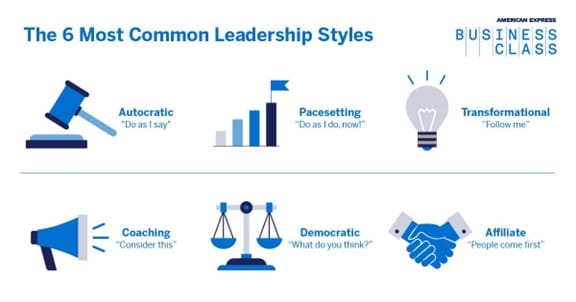A leader must command the trust and motivation of their whole team, setting the direction of travel and ensuring everybody moves forward together as a unit. A good leader may display traits of decisiveness, trustworthiness, clear communication, resilience and the empowerment of others.
But leaders often adopt one dominant style that stems from their preferences, personality, and background. Knowing which leadership style works best for you is part of being a capable leader, but sticking to one style can stifle your growth.
It's important to develop a style that integrates effective leadership practices. This will help you adapt to new situations and enhance your effectiveness as a leader.
Here’s a look at these types of leadership styles, their advantages and disadvantages, and how to develop your signature style while allowing you to stretch into other styles as needed.
 |
1. Autocratic leadership style
What is autocratic leadership?
The phrase most illustrative of an autocratic leadership style is "Do as I say." Autocratic leaders establish a clear vision of an end goal and how to achieve it. They set specific guidelines and clear expectations for what, when, and how tasks should be done. These leaders expect others to accept their directives at face value and carry them out promptly.
Characteristics of autocratic leadership
Leaders who adopt this type are often deeply focused on achieving efficient results through established actions they believe are in the business’s best interest. An autocratic leader might sometimes make decisions with a small group of trusted peers.
In practice, autocratic leadership involves centralised decision-making, firm control of tasks, limited team input, clear expectations, quick implementation and a top-down communication structure.
Autocratic leadership in practice
When autocratic leadership is most effective
Autocratic leadership is most effective when consistent, predictable results are critical, especially in highly regulated industries like healthcare and construction. Autocratic leaders may also thrive more around new or inexperienced employees who need clear guidance, and there's little time for discussion.
Advantages of autocratic leadership
- Quick decision-making, especially critical for effective crisis management.
- Clear rules and guidelines for consistent results.
Disadvantages of autocratic leadership
- If employees don’t have sufficient confidence or trust in the leader, they might not feel comfortable carrying out instructions.
- This style can sacrifice creativity by minimising group input.
2. Pacesetting leadership style
What is pacesetting leadership?
The phrase most indicative of the pacesetting leadership style is "Do as I do, now!" Pacesetting leaders expect consistent results and self-direction. They push team members to run hard and fast to the finish line.
Characteristics of pacesetting leadership
Pacesetting leaders are typically highly energetic. They roll up their sleeves and dive into the action, leading by example and setting high expectations. The goal is to drive results efficiently, whether working against deadlines or developing a new product or service.
Do you describe yourself as a leader who uses a pacesetting style? If so, be aware that a pacesetting type of leadership style creates a high-pressure environment. Not all employees thrive in that type of culture.
In practice, pacesetting leadership involves high team expectations, a fast-paced work environment, leading by example and being results-orientated.
Pacesetting leadership in practice
When pacesetting leadership is most effective
Pacesetting leadership may be most effective when working with highly motivated employees who also like to move and see results quickly. It may also be effective when a crucial deadline must be met, especially in a production or manufacturing environment or in the legal sector.
Advantages of pacesetting leadership
- It can be an effective way to quickly hit goals, accomplish objectives, and achieve results.
- High, dynamic energy can be engaging for employees who thrive in a fast-paced workplace.
Disadvantages of pacesetting leadership
- Fast-paced, high-pressure workspaces can frequently lead to mistakes.
- Employees who thrive on mentorship and individual feedback may not flourish.
3. Transformational Leadership Style
What is transformational leadership?
The phrase that best describes this leadership style is "Follow me." Transformational leaders, known as visionary leaders, are firmly committed to organisational purpose and big-picture goals.
Characteristics of transformational leadership
They tend to set objectives by outlining the direction the business will take and what will happen when they get there.
This inspired, future-focused vision sets expectations that engage and energise employees. Transformational leaders also encourage and empower team members to step out of their comfort zones for professional development and organisational achievement.
In practice, transformational leadership involves an inspiring vision, promoting innovation, encouraging personal development amongst team members, empowering stakeholders, clear communication and building trust.
Transformational leadership in practice
When transformational leadership is most effective
Transformational leadership is most effective in fast-growing organisations or businesses that need a new sense of direction. It may also be effective during corporate restructuring, mergers and acquisitions, and other high-risk business transformations.
Advantages of transformational leadership
- There's a high value in the company’s long-term goals.
- It can help accelerate business growth.
- It may boost employee morale and retention if workers feel genuinely connected to company goals.
Disadvantages of transformational leadership
- Focusing on the big picture constantly can risk overlooking the operational details and neglecting to hold people accountable.
- You may need to catch up on short-term results while concentrating on long-term goals.
- If leaders don’t devote appropriate time to align middle managers with the strategic vision, strategic change can slow down or even fail.
4. Coaching leadership style
What is coaching leadership?
The most descriptive phrase for the coaching leadership style is "Consider this." Coaching leaders view their teams as a pool of talent to be developed. Like personal trainers, these leaders give employees the direction needed to tap into their abilities and reach their full potential. However, coaching leaders must be careful not to overdo giving directions to avoid micromanaging.
Characteristics of coaching leadership
Through regular feedback, coaching leaders recognise and nurture an employee’s strengths while providing inspirational guidance for improving weaknesses. The coaching leadership style is similar to transformational leadership, but it emphasises the employees’ long-term potential and how their individual goals fit into the company’s overall vision.
In practice, coaching leadership involves understanding each team member's strengths, weaknesses, goals and aspirations. It also involves providing regular feedback, a focus on development, active listening, encouraging self-reflection and providing a generally supportive and empowering environment.
Coaching leadership in practice
When coaching leadership is most effective
Coaching leadership is most effective when leaders have the time to devote to individual employees and employees know their limitations and are open to change and challenges.
Advantages of coaching leadership
- Regular encouragement can boost individual and team confidence and morale.
- Individualised attention can aid in skill development.
- Coaching can inherently foster a positive work environment.
Disadvantages of coaching leadership
- Coaching leadership is time-intensive and requires patience.
- Some employees may struggle to be receptive and instead feel they’re being micromanaged.
- Managers would often need to complete training and develop their coaching skills.
5. Democratic leadership style
What is democratic leadership?
The hallmark phrase of this leadership style is "What do you think?" Democratic leaders, or participative leaders, look for employee input before making decisions. The leader might present a problem and get suggestions from the entire team before establishing an official course of action.
Characteristics of democratic leadership
The goal of democratic leadership is to have a dialogue and discussion that encourages group participation and gains everyone’s confidence in the chosen course of action. Ultimately, however, democratic leaders get the final say.
In practice, democratic leadership involves inclusive decision-making, open communication, encouraging collaboration, consensus building, shared accountability and respect for other opinions.
Democratic leadership in practice
When democratic leadership is most effective
Democratic leadership is most effective when a company needs to surface fresh ideas on how to implement a vision and the leader is unsure of the best course of action and requires input from trusted employees.
Advantages of democratic leadership
- Gives all employees a voice, boosting engagement, morale and retention.
- Can help build trust and confidence in leadership.
- Fosters creativity.
Disadvantages of democratic leadership
- May prolong the decision-making process.
- It can backfire if employees feel their input is ignored, resulting in lower employee productivity and satisfaction.
- A lack of direction may confuse some employees and lead to inefficiencies.
6. Affiliative Leadership Style
What is affiliate leadership?
A phrase often used to describe this type of leadership is "People come first." Affiliative leaders, also known as facilitative leaders, aim to put employees first. They manage by fostering genuine emotional bonds which promote loyalty and trust.
Characteristics of affiliate leadership
Affiliative leaders pay close attention to employees and support their emotional and professional needs. Most decisions are left to employees, but the leader is still part of the decision-making process. Affiliative leaders frequently use praise, encouragement, and support to boost individual and team-wide confidence. Ultimately, this is an effective leadership style that promotes harmony and establishes cooperative team relationships.
You can use the American Express® Business Gold Card to foster genuine bonds with your employees through rewards. For every full and eligible £1 spent on everyday business purchases, you’ll earn 1 Membership Rewards® point. Points can be redeemed with hundreds of retailers across retail, travel and dining. You could use your points on retail Gift Cards, like beauty or gaming subscriptions, for example, and reward loyalty and hard work through an employee of the month scheme. Or, you could treat your workers to a team day out using exclusive travel rewards¹.
In practice, affiliate leadership involves putting employees first, emphasising team harmony, building strong relationships, fostering collaboration, providing positive feedback and creating a supportive culture.
Affiliate leadership in practice
When affiliate leadership is most effective
Affiliative leadership is most effective when morale is low or there are conflicts among team members. It may also be effective during stressful periods, like when the organisation is short-staffed and when affiliative leaders have strong communication skills and can calmly address conflict.
Advantages of affiliative leadership
- Morale, retention, and employee happiness will likely thrive because affiliative leaders prioritise employee well-being.
- It can boost creativity and innovation as employees are invited to participate in discussions and given room to share creative ideas and suggestions.
- Conflict may be resolved more quickly.
Disadvantages of affiliative leadership
- If not kept in check, a deep focus on individuals' needs can overshadow the team’s needs.
- If underperforming team members aren't effectively managed, productivity may suffer.
What leadership style is right for me?
In choosing from the different types of leadership, it's important to remember that the ideal leadership style depends not only on the leader's personality but also on their team members and the situation.
How do you choose the right leadership style?
Developing a signature leadership style while adapting your practices for certain circumstances can help enhance your overall effectiveness, benefitting you, your employees, and the business. You can follow certain steps to identify the right leadership style:
- Choose a leadership framework
- Identify your strengths and weaknesses
- Take a leadership style assessment
- Consider the traits you admire in leaders
- Keep your business goals top of mind
What are the factors for selecting a leadership style?
When considering a leadership style, business owners may wish to evaluate each of the following variables to establish which is right for them:
- Professional experience
- Personality type
- Belief system
- Company culture
- Employee diversity
- Personality traits
- Level of control
- Organisational structure.
1. If you'd prefer a Card with no annual fee, rewards or other features, an alternative option is available – the Business Basic Card. Membership Rewards points are earned on every full and eligible £1 spent and charged, per transaction. Terms and conditions apply.



